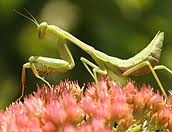By Juliann Clarke, Butte County Master Gardener, March 7, 2014
In March, some nurseries will start selling the egg cases of Chinese mantis, as a biological control for your garden. These alien-looking insects are Praying Mantis and are harmless to humans, but have an insatiable appetite for aphids, caterpillars and other insects. They are masters of disguise, hiding amongst vegetation for camouflage and to stalk their prey. They will often attack and eat things larger than themselves; lizards, frogs and even birds. They are not considered a beneficial bug because they not only eat bad bugs but also good bugs, so they are of little value in biological control.
Praying mantises get their name from the Greek word mantikos, which means soothsayer or prophet, and the fact that when their fore-limbs are folded they appear to be “praying.” But beware – when in the upright position, these specialized front legs with sharp spines can capture prey with lightning speed.
The mantis or mantid (insect) is part of the mantidae family. There are about 2,000 species of mantises worldwide, most of which live in warmer, subtropical climates. But the United States is home to at least three mantis species: the Chinese mantis, which was introduced in the late 1800's or early 1900's; the European mantis, which is pale green and only half the size of the Chinese mantis; and the Carolina mantis, the only mantis species considered native to the U.S.
The mantis is related to the grasshopper, the cricket and the termite. It has two large bulbous compound eyes capable of seeing shapes and colors, a mouth designed to chew, and very distinct wings. Because the mantis has only one ear, located on the underside of its belly, it cannot discriminate the direction or frequency of sound, but it is able to detect ultrasound. This helps protect the mantis from being eaten by bats, which produce ultrasound.
The praying mantis is unique among insects in its ability to turn its head a full 180 degrees, so it is difficult to approach them undetected. A flexible joint between the head and prothorax enables them to rotate their heads. Mantises do not like to get wet.
Praying mantises mate in the autumn and sometimes eat their mates. The female carries her eggs for a time, then deposits them on a twig, stem or fence with a spongy, “Styrofoam-like” substance she secretes. This substance forms a protective egg case for the offspring to develop in over the winter. Praying mantises can grow to well over 6 inches. There are three distinct stages of growth from infancy to adulthood: egg, nymph and adult. Once the egg hatches, a baby (the nymph) appears. It resembles its mother except it is much smaller in size and wingless. These nymphs have an exoskeleton (a skeleton on the outside of the body). When the nymph becomes too large, it sheds the flexible exoskeleton and forms a new one. This process is called molting and can occur up to ten times, depending on the species of mantis. During the last molting, the mantises emerge with thin, transparent wings.
If you introduce these fascinating creatures into your garden, beware of their voracious appetites. They are just as likely to eat a native bee or butterfly usefully pollinating your plants as they are to feast on an aphid. And should you bring one of their egg cases into your warm house, do not be surprised if one morning you awake to hundreds of baby mantises, since one egg case can contains as many as 200 eggs.
For more information, see:
Doutt, R. L., Professor of Entomology, Emeritus, Division of Biological Control, Parlier. The Praying Mantis. University of Davis. Leaflet 21019.
Garvey, Kathy Keatley. Up Close & Personal With A Praying Mantis. Division of Agriculture & Natural Resources, University of Davis. California Master Gardeners Program.
Praying Mantid Information. Center for Insect Science Education Outreach, The University of Arizona.